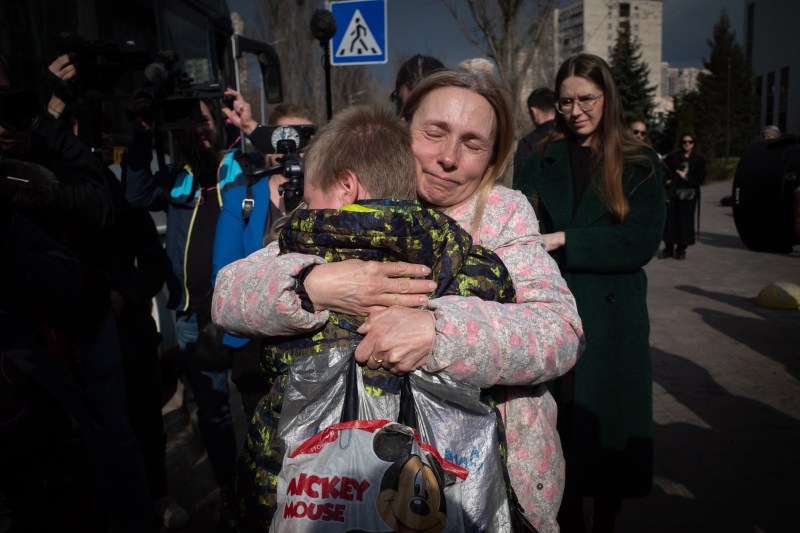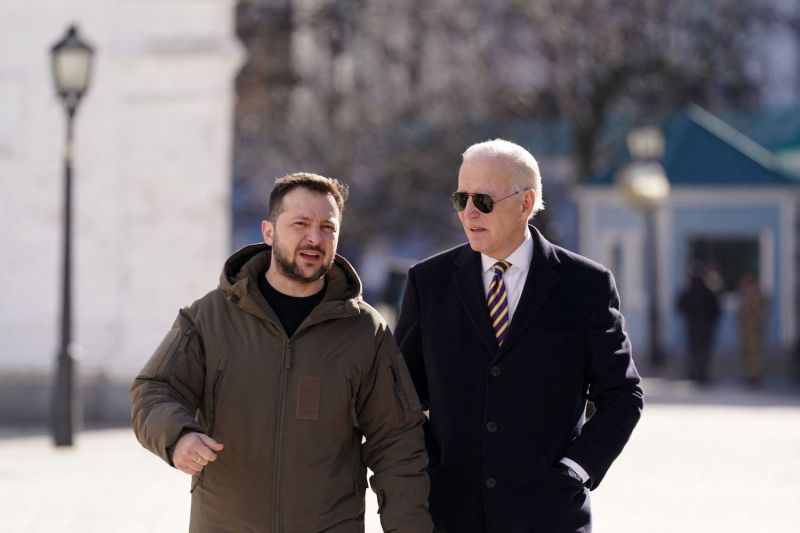Ukraine Starts to Rebuild After Russia’s Rampage
But some damage can’t be fixed by bricks and mortar.
NEAR HOSTOMEL, Ukraine—For 20 years, Liudmyla Savenko lived in a small, two-story house on top of a hill, the highest point in her village, near Kyiv. When Russia invaded, she used the vantage point to report enemy movements to Ukraine’s military. Now her house is a pile of rubble.
NEAR HOSTOMEL, Ukraine—For 20 years, Liudmyla Savenko lived in a small, two-story house on top of a hill, the highest point in her village, near Kyiv. When Russia invaded, she used the vantage point to report enemy movements to Ukraine’s military. Now her house is a pile of rubble.
Located to the northwest of Ukraine’s capital, right between the village of Moshchun and Hostomel Airport, Savenko’s house was on the front lines from the first days of Russia’s full-scale invasion in February 2022. She watched it from her living room window. A 59-year-old first grade teacher, she reported the first flight of 20 helicopters that fluttered over the trees near the Irpin River. When a column of tanks and troops appeared in a nearby field, she called it in, and Ukrainian forces came out to meet them. They pounded each other with artillery.
And then the Russians pounded her house, hitting it with an artillery shell on March 9, 2022. Flames gutted the place, destroying most of her belongings. She spent months living in the basement before finding refuge elsewhere. “We lost everything, even the photos of my children and grandchildren,” Savenko said.
Now, even with the war ongoing, Savenko is looking to start rebuilding. On a recent Sunday morning, a team of around 20 volunteers from Brave to Rebuild, a volunteer initiative that helps people whose homes were damaged by the Russian invasion, arrived to start clearing away the rubble and the debris and the bad memories. Over the past seven months, the team—made up of volunteers from Ukraine, Canada, the United States, and farther afield—has been working to restore nearly 300 shattered houses. They piled spent shrapnel on the stump of a just-felled tree and stacked fresh bricks for the new house. Savenko and her husband don’t have the money to start rebuilding just yet but cherish these first steps.
Ukrainian President Volodymyr Zelensky said this month that some 1,900 Ukrainian cities and villages are in need of reconstruction. It is, he said, “the largest economic project in Europe in several generations.” The Kyiv School of Economics has estimated the total cost of Russia’s invasion at about $144 billion, including damage to the environment and the destruction of railroads, hospitals, and schools. More than 153,000 residential buildings have been either damaged or destroyed, a missile-directed write-off exceeding $50 billion.
A scene of the war’s destruction in the Novokodatsky district of Dnipro, Ukraine, on March 11, 2022.
As with any remodeling, the final tally will be a lot higher. The World Bank, United Nations, and European Union figure it will take at least $400 billion to rebuild. That’s roughly double Ukraine’s annual GDP: It’s as if the United States were hit with a $46 trillion bar tab. Ukraine plans to fund the reconstruction through a combination of state-organized projects, paid for locally and internationally, and by attracting private capital. U.S. asset management firm BlackRock has agreed to help coordinate investment. Its head, Larry Fink, said in January that Western investors will be “flooding” in after the war and the country could become a “beacon to the rest of the world of the power of capitalism.”
Even now, with fighting ongoing, UkraineInvest, Kyiv’s investment promotion office, is attracting interest. The office has nearly 20 projects worth $2.3 billion running already and expect $3 billion to $5 billion in investment over the next two years in industry alone. Some companies are taking big risks to get ahead of what is expected to be a gold rush. The largest interest so far has come from those who produce construction materials and process agricultural goods.
“Private capital is very important: When it enters Ukraine, it sends a positive signal to other investors,” said Sergiy Tsivkach, the CEO of UkraineInvest. “It will bring technology, access to supply chains, and the best international practices in operating business in a transparent and effective way.”
States are also ponying up, with more than 50 countries pitching in. The United Kingdom is focusing on Kyiv; Denmark is working on Mykolaiv, due to its ties to the city’s shipbuilding industry. British architect Norman Foster, known for his modern creations in steel and glass, offered his services last year to rebuild central Kharkiv for free and has since developed a masterplan for the city. In Kyiv and its now infamous suburbs, roads, malls, and bridges that lay in tatters last year are being brought back to life. Tower blocks that had holes scored into them by missiles have been repaired. Yablonska Street in Bucha, once strewn with the bodies of slain civilians in one of the most tragic episodes of the war, is now dotted with backhoes and construction workers.
- The remains of the Irpin-Bucha bridge on the outskirts of Kyiv on April 10.
- Construction workers work to rebuild the Irpin-Bucha bridge in Kyiv on April 10.
The remains of the Irpin-Bucha bridge, under which a crowd of terrified people sheltered from artillery strikes as they tried to flee the area last year, are being turned into a war memorial. The Turkish construction company Onur, which is building a new bridge next to it, said work began last fall and is scheduled to open to traffic by the end of the year. It is funded by the Ukrainian state, although three other bridges Onur is rebuilding are being paid for by U.K. Export Finance, the U.K. government’s export credit agency.
Beyond the famous landmarks of the war, a major test for Ukraine will be its ability to draw investment into the rebuilding of little-known areas, such as the villages and farming settlements in the Donbas region that have been reduced to ash. Donald Bowser, the founder of Support to Ukrainian Recovery Initiative, said there has so far been little donor interest in early recovery work outside of Kyiv or big cities. Most donations to the country are still focused on humanitarian aid.
“People say they don’t want to rebuild as it will get destroyed again. Yet the people who live along the contact line have already suffered for nine years. People still need services and infrastructure,” Bowser said. The initiative attempted to raise $170,000 to rebuild a dairy farm that would employ an entire town last year in Mala Rohan, near Kharkiv, but there was little interest.
Rebuilding is a minefield—literally. Ukraine is now one of the most heavily mined countries in the world, with about 30 percent of the total area contaminated, according to Ukraine’s State Emergency Service. Even if the war ended tomorrow, it would take years to clean up the unexploded ordnance.
Another thing that could blow up is Ukraine’s past reputation for corruption. “Few lessons have been learned from the last nine years of war,” Bowser said. However, Ukraine is not the same country that it was before the full-scale invasion. “There is a new society, who don’t have the tolerance for corruption that they did,” he said, pointing out how many people have been involved in humanitarian and fundraising efforts. “People will watch how the money is spent—they’re not going to sit back while everything gets stolen.”
Savenko poses during work on her destroyed house near Kyiv on March 25.
Some things are going to be harder to rebuild, regardless of ready cash or fresh bricks. For Savenko, who has just begun rebuilding her house, it would take a lot more than an army of tea-drinking volunteers to heal the rift the invasion tore through her family. Her aunt, uncle, and sister live in Minsk, Belarus, and used to visit every year, but now they support Moscow’s “special operation.”
“My sister would say, ‘Your poor country is nothing. Ukraine is a doll in America’s hand,’ and all these phrases from Russian propaganda,” Savenko said, adding that all her family members were born in western Ukraine. When her house was on fire, she sent an image of it engulfed in flames to her sister, but there was no response.
“Now I have deleted her number and erased her address,” Savenko said. “I will never speak to her again.”
Liz Cookman is a journalist based in Ukraine covering the human cost of the war. Twitter: @Liz_Cookman
More from Foreign Policy

The Trump/Vance Unilateralist Delusion
The Republican ticket has unified—around a fundamentally unrealistic foreign policy.

Harris Candidacy Gives Democrats a Chance to Pivot on Gaza
What she can do to right U.S. foreign policy and bring back voters.

China and the U.S. Are Careening Toward a South China Sea Crisis
A failure of deterrence risks pushing the region into deeper conflict.

The Kamala Harris Doctrine
Everything we know about the presumptive Democratic nominee’s foreign-policy views.












Join the Conversation
Commenting on this and other recent articles is just one benefit of a Foreign Policy subscription.
Already a subscriber? .
Subscribe Subscribe
View Comments
Join the Conversation
Join the conversation on this and other recent Foreign Policy articles when you subscribe now.
Subscribe Subscribe
Not your account?
View Comments
Join the Conversation
Please follow our comment guidelines, stay on topic, and be civil, courteous, and respectful of others’ beliefs.